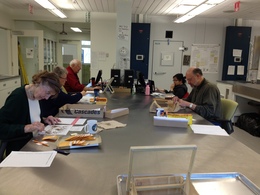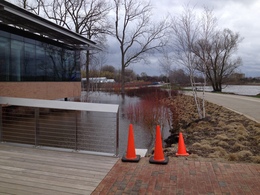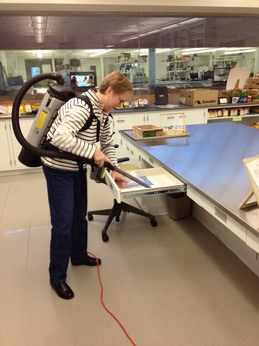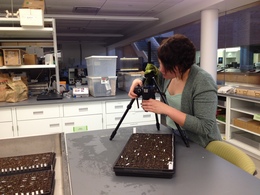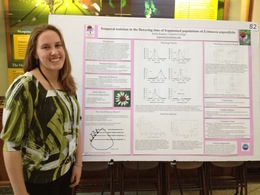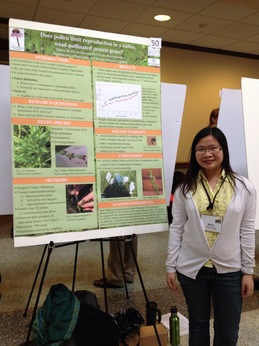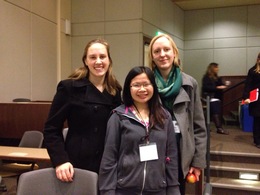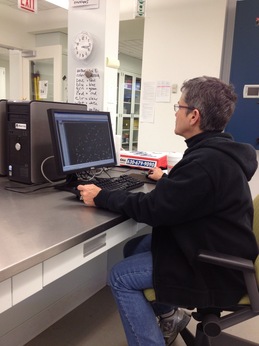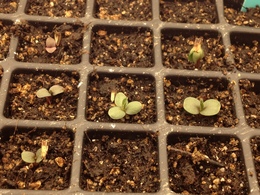|
|
June is a transitional time for the Echinacea Project. Stuart left for Minnesota last Saturday and has begun working with a new crop of field interns. They will update the flog throughout the summer to introduce themselves and describe their adventures.
Stuart’s four advisees at Northwestern–Josh Drizin, Katherine Muller, Karen Taira, and Maria Wang–are getting ready to move on to new endeavors. Maria is staying at Northwestern for one more year to complete a Master’s degree. As much as she loves her grasses, she is embarking on a topic closer to her home territory: the population genetics of a Malaysian crop species. Katherine is moving on to a PhD program at the University of Minnesota, Josh is applying for conservation jobs, and Karen is preparing to defend her thesis in the fall.
Back in the lab, there is enough counting, randomizing, and weighing to keep our volunteers busy all summer. All of the counting for harvest years 2010 through 2012 have been entered into the new online data entry system at echinaceaproject.org/lab. That means that we will be able to keep track of their progress throughout the summer without the hassle of paper datasheets. As of today, 69% of the assignments have been completed. Counting for 2010 is nearly finished and 2011 is over half-way there.

There was one project we did not get to this year. In the summer of 2012, field intern Kelly Kapsar observed flowering times for Echinacea in burned and unburned areas of the Staffanson prairie preserve. At the end of the summer, she collected the flowering heads in order to assess the relationship between flowering time and seed set. Various students have worked on aspects of the project. In November, Mindy Runge and Ale Mendoza (Lakeforest College) extracted and weighed achenes (click here to see their poster). In December, Marie Schaedel (Carleton College) weighed additional achenes and assessed our methods of judging whether an achene is full or empty (click here to read her results ). Most recently, Jill Pastick (Lakeforest College) finished extracting achenes and helped organize the collection.
These steps (extracting and weighing achenes) allow us to draw a relationship between flowering time and seed set (i.e. the proportion of full vs. empty achenes). The next step of this study will be to germinate the achenes and plant them in the field. Unfortunately, that will have to wait until next year. In the meantime, the collection of weighed and organized achenes will be stored in the freezer.

Last week I gave a public presentation describing my M.S. thesis with the Echinacea Project. After two summers of field work and eight months of data analysis and writing, I managed to succeed in passing my defense. I have included a link to my presentation slides. They do not include much in the way of explanatory text, but they have an abundance of pictures and graphs along with a dash of poetry.

ThesisPresentationFinal.pdf
The Thursday crowd is undertaking variety of tasks today: Bob (back left) is counting achenes using the new online data entry system, Char and Suzanne (left) are taking a random sample of achenes to weigh, Bill (front right) is extracting achenes from Echinacea heads, and Maria (back right) is working on her senior thesis on pollen limitation in a prairie grass. Gia (not shown) is identifying ants from the Staffenson prairie preserve.

Due to the epic storm system pummeling the midwest, the Chicago area has experienced quite a bit of flooding over the past few days. The cute little lagoons dotting the Chicago Botanic Gardens have grown into murky lakes. Access to service roads is restricted by flooding. One upside to all the rain is that the Plant Science Center (home of our lab) has acquired a moat fine enough for any medieval fortress:

Something about springtime makes you more aware of the layers of grime covering every surface of your life. Thankfully, volunteers Leslie and Anne agreed to help us battle the accumulated dust throughout lab. Believe it or not, this is a vacuum cleaner, not a ghost-busting device.

Now that the lab is sparkling, clean, and free of ghosts, we can continue our scientific endeavors in a grime-free environment.
Spring is a hectic time for most biota; interns are no exception.
The lab currently has two undergraduate interns working on separate projects. Jill Pastick (Lakeforest College) is studying hybridization between native Echinacea angustifolia and non-native Echinacea pallida in Minnesota. This project began with Nicholas Goldsmith, who performed a hybrid crossing experiment in the summer of 2011 and observing pollination success based on style persistence. Shona Sanford continued his project by performing a second crossing experiment in the summer of 2012 and weighing achenes to determine whether or not they contained seeds. Jill is continuing the project by the germinating the achenes from Shona’s study to assess their survival and growth. She is currently photographing the seedlings to take detailed measurements on size and color.

Our other intern, Gia Hallaman (Northwestern), returned to the lab this week after spending her spring break volunteering on an organic farm in Wisconsin. She is in the process of curating and identifying ants collected by Jill Gall in the summer of 2012. Jill’s collection covered 6 prairie remnants throughout Douglas County Minnesota. So far, Gia has identified a subset of ants from all 6 sites. For her project, she is going to focus her effort on the Staffenson prairie preserve in order to compare the ant community in the burned and unburned units.

This past weekend, three students associated with the Echinacea Project presented their work at the Midwest Ecology and Evolution Conference at Notre Dame.
Kelly Kapsar (Carleton College, 2014) spent the winter analyzing her data on flowering phenology in prairie remants and presented her results in a poster.

Maria Wang (Northwestern, 2013) presented the results of her undergraduate honors thesis on pollen limitation in the prairie grass Dicanthelium.

Master’s student Katherine Muller gave an oral presentation on her research on the relationship between Echinacea and its specialist aphid.

I should mention that Maria was recently accepted as a Master’s student in the Northwestern Program in Plant Biology and Conservation. She will graduate this summer and remain in Chicago another year to finish her M.S.. She will be working with Dr. Nyree Zerega investigating the genetic origins of tropical crops. Although we will miss her in the Echinacea Project, we wish her the best in her next endeavor.

This week marks several milestones in the lab. First, the volunteers completed randomizing and weighing achenes from the 2011 harvest of a large experimental plot planted in 1999. This experiment looks for genetic differences among maternal populations by combining their offspring in a common environment and measuring a variety of traits, including seed set. Weighing is the last step in data collection for this experiment. Although we have a long way to go in processing 2011 data for other experiments, we are making good progress.
Another milestone this week is the launch of our new online data entry system for achene counts. Bianca Rosenbaum, the web developer at the Chicago Botanic Garden, has created an interface that allows volunteers log into the website, open scanned images, and enter data into a web form. In addition to doing away with paper datasheets, this will improve our ability to catch mistakes, such as mis-labeled scan files. Anne Coughlin was the first volunteer to try the new system.

In other news, intern Jill Pastick has begun the pre-germination phase for an experiment assessing the growth of Echinacea angustifolia x pallida hybrids. This will add to Shona Sanford’s work on style persistence and seed set of hybrid crosses. Click the link to read about Shona’s most recent findings on Echinacea hybrids: (https://echinaceaproject.org/wp-content/uploads/2013/02/more-work-with-e-angustifolia.html).
Every so often, an Echinacea seedling emerges with an extra cotyledon. I introduce to you, the tricot:

These are the seedlings from Jill Pastick’s experiment comparing Echinacea germination in agar vs. blotter paper. That picture was from last week (Feb. 19). Here is what they look like today (Feb. 27):

In other news, we are moving forward in developing an online data entry system for counting achenes. Stuart and I are beta-testing and Bianca, the CBG web developer, is refining the data management system. We will commence counting very soon.
|
|



-thumb-260x346-154543.jpg)
